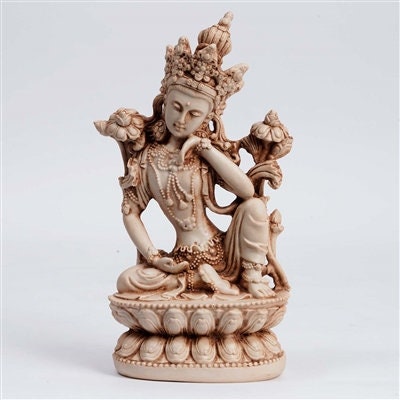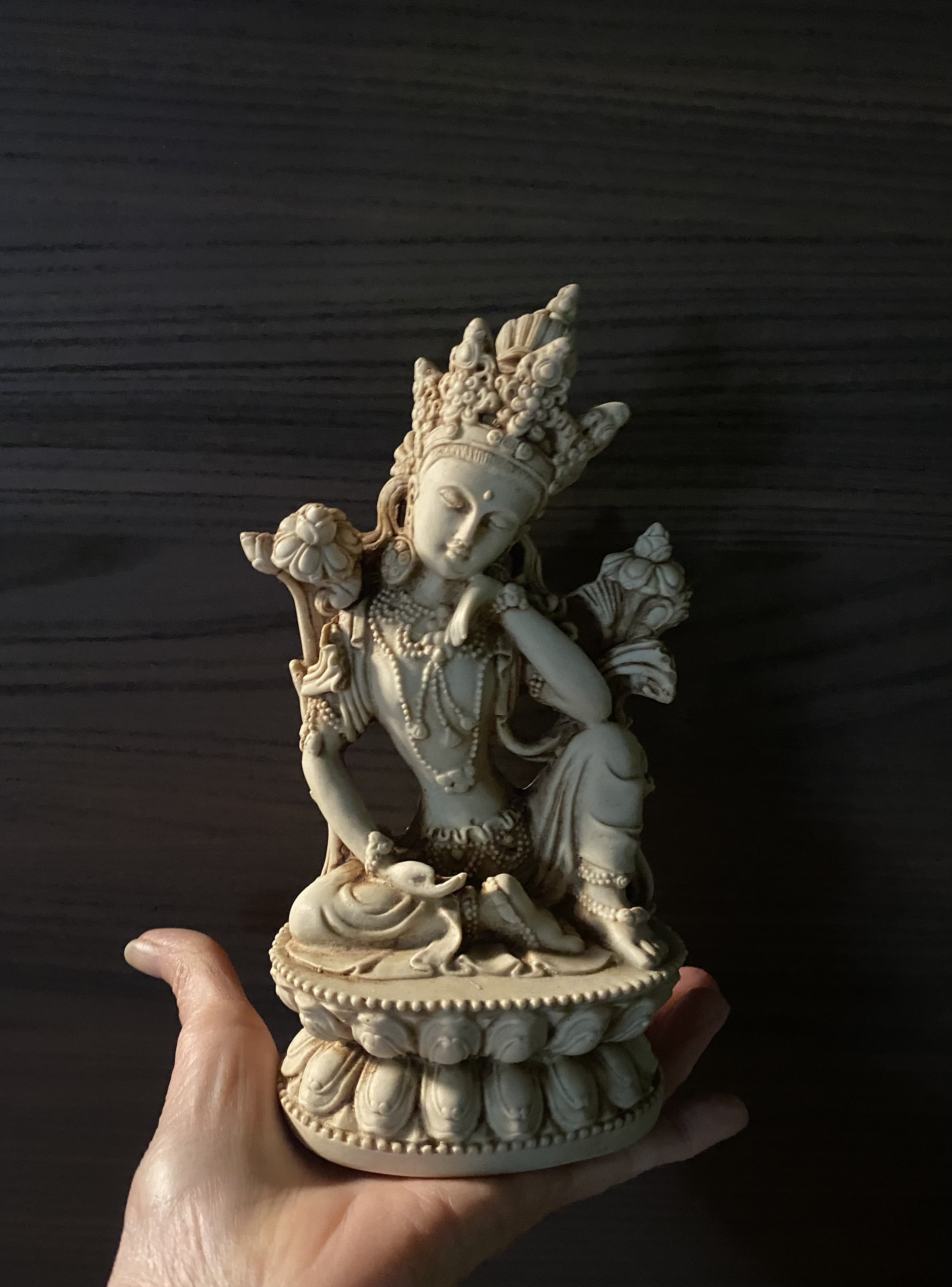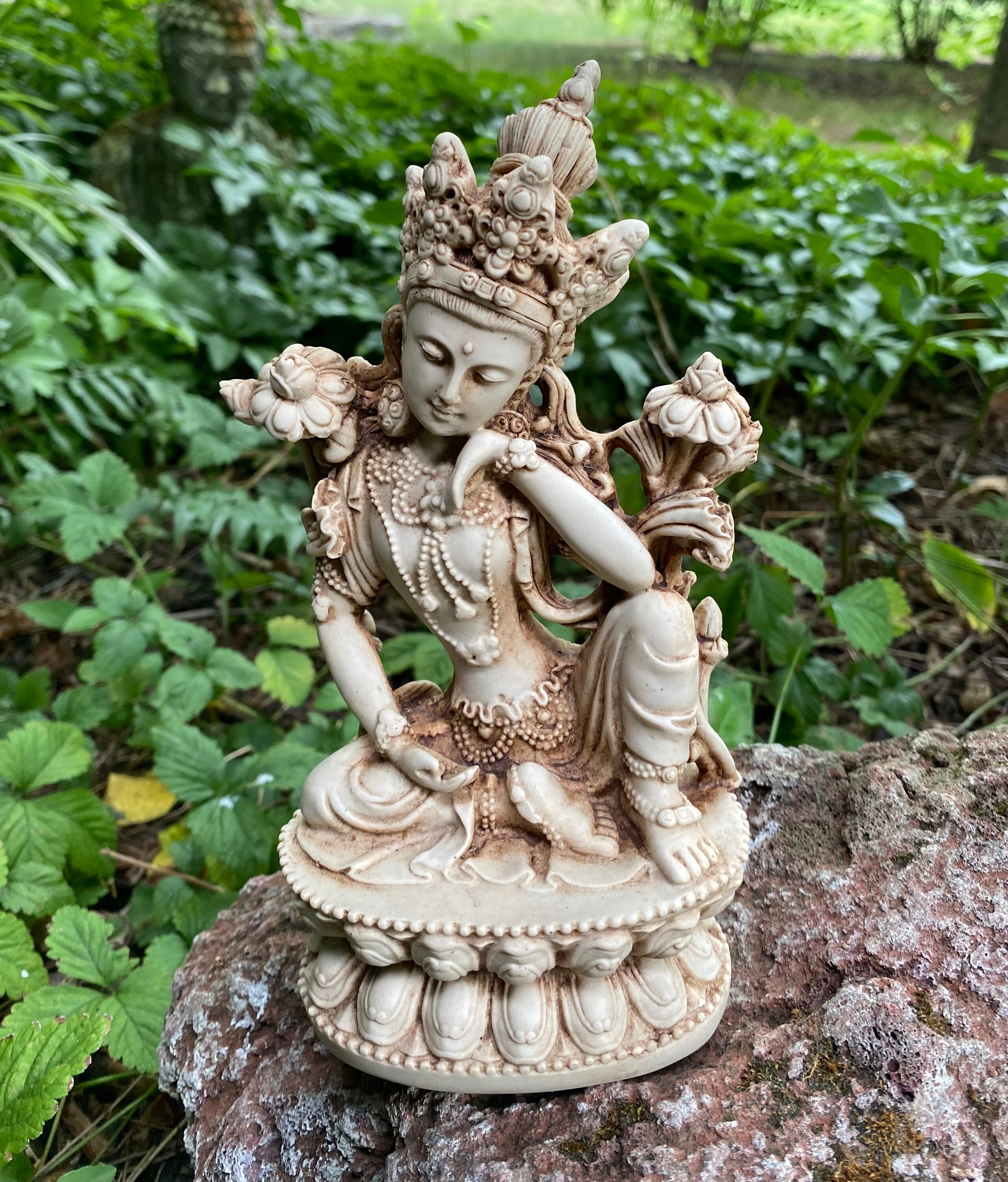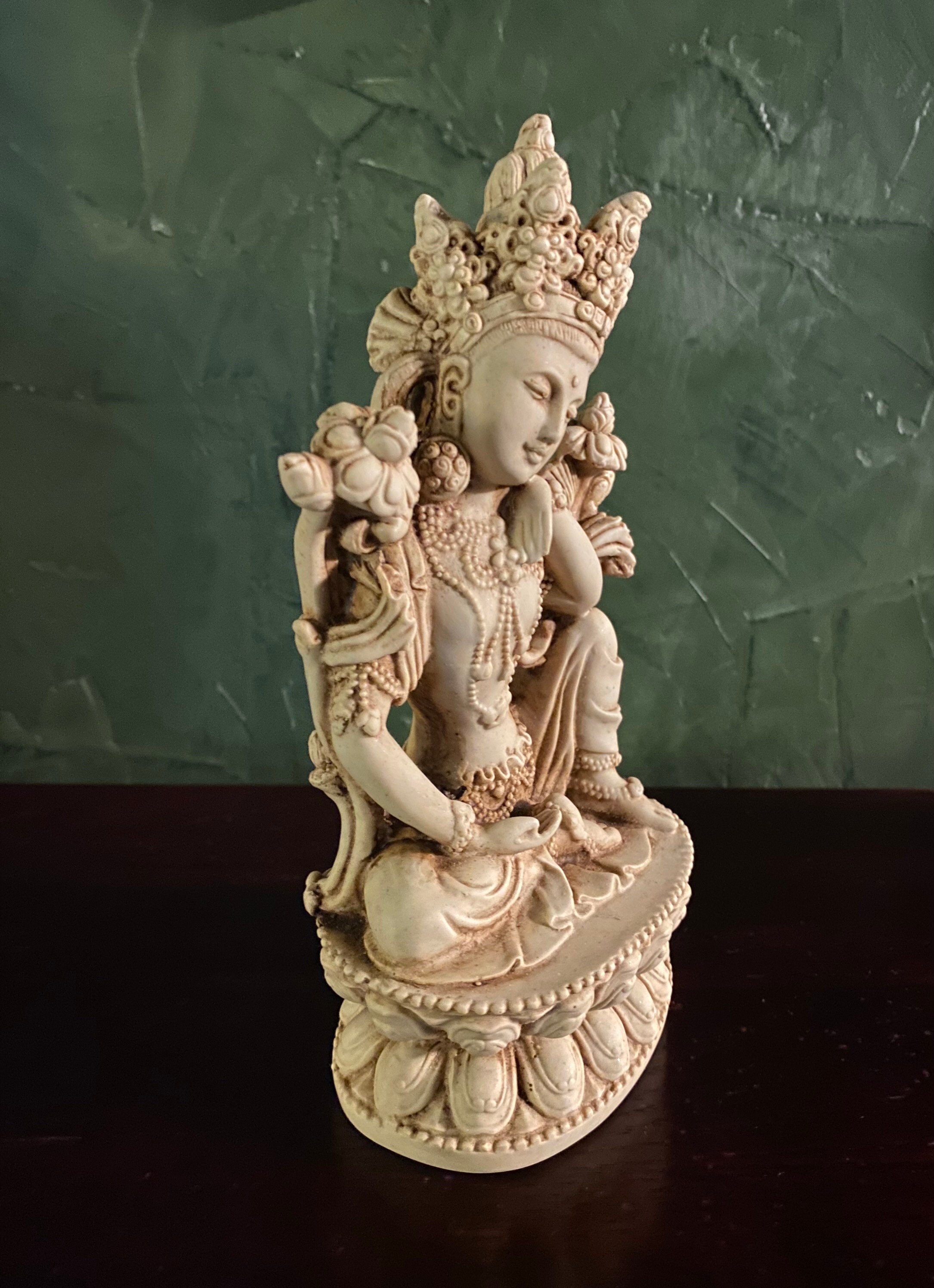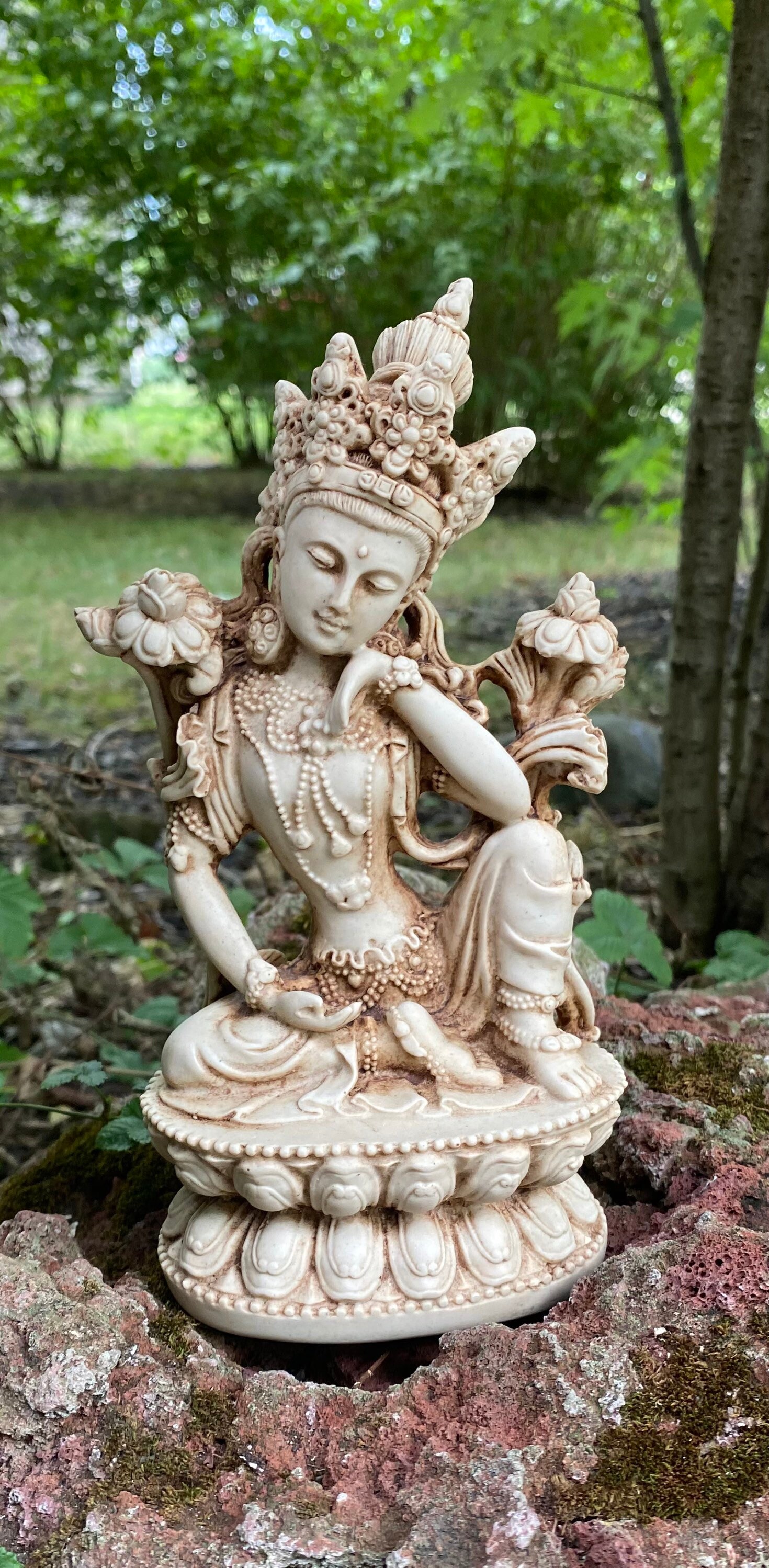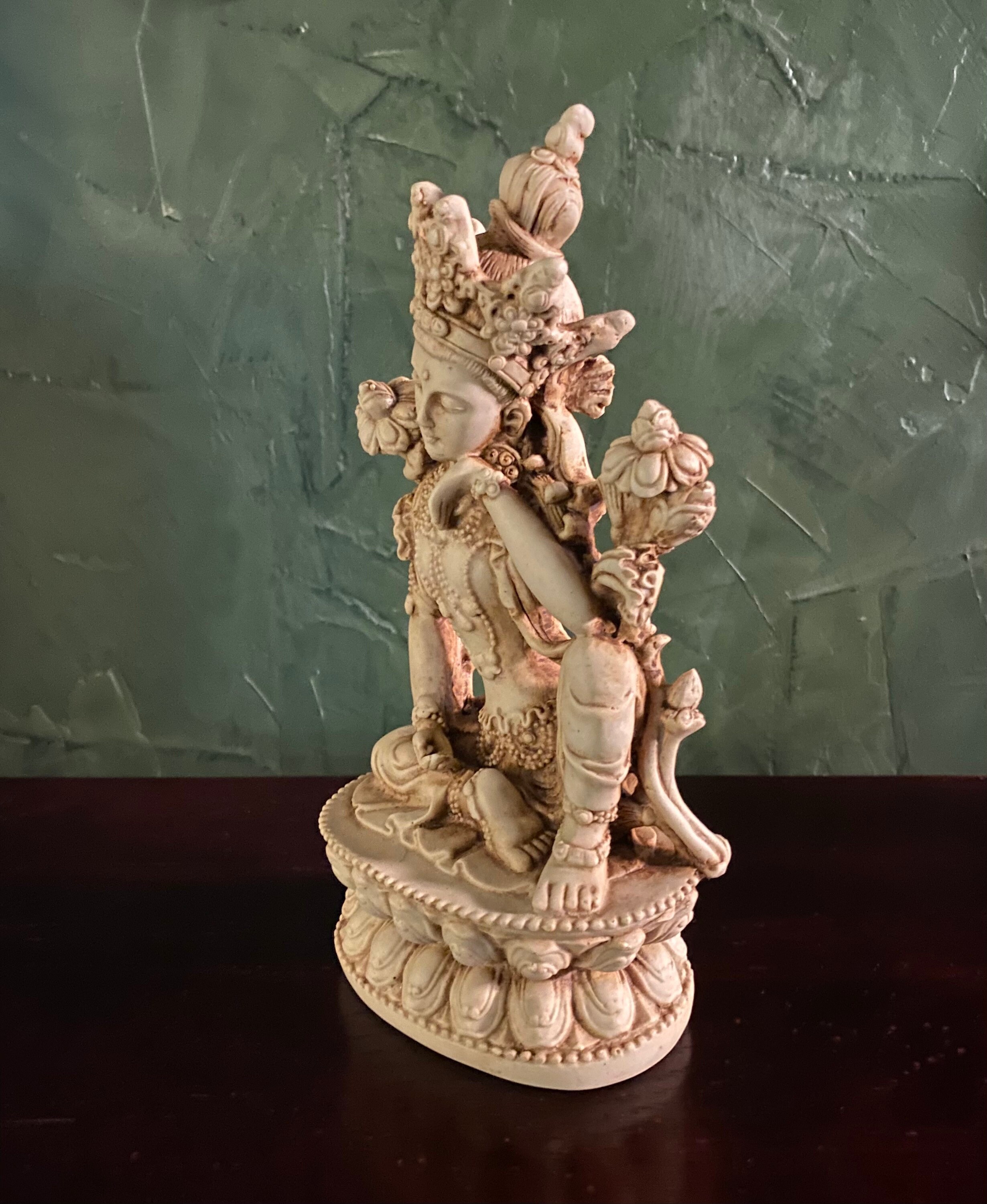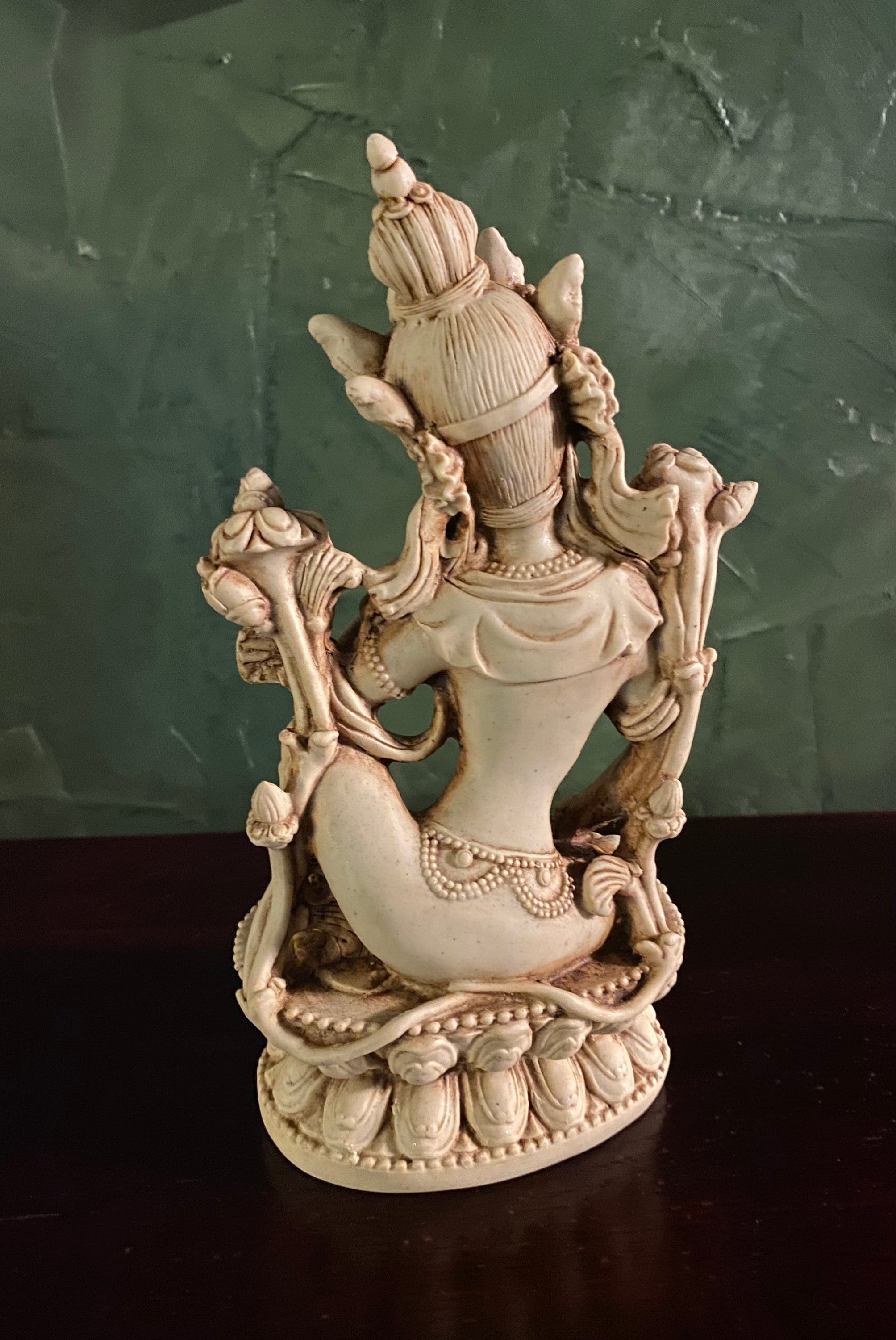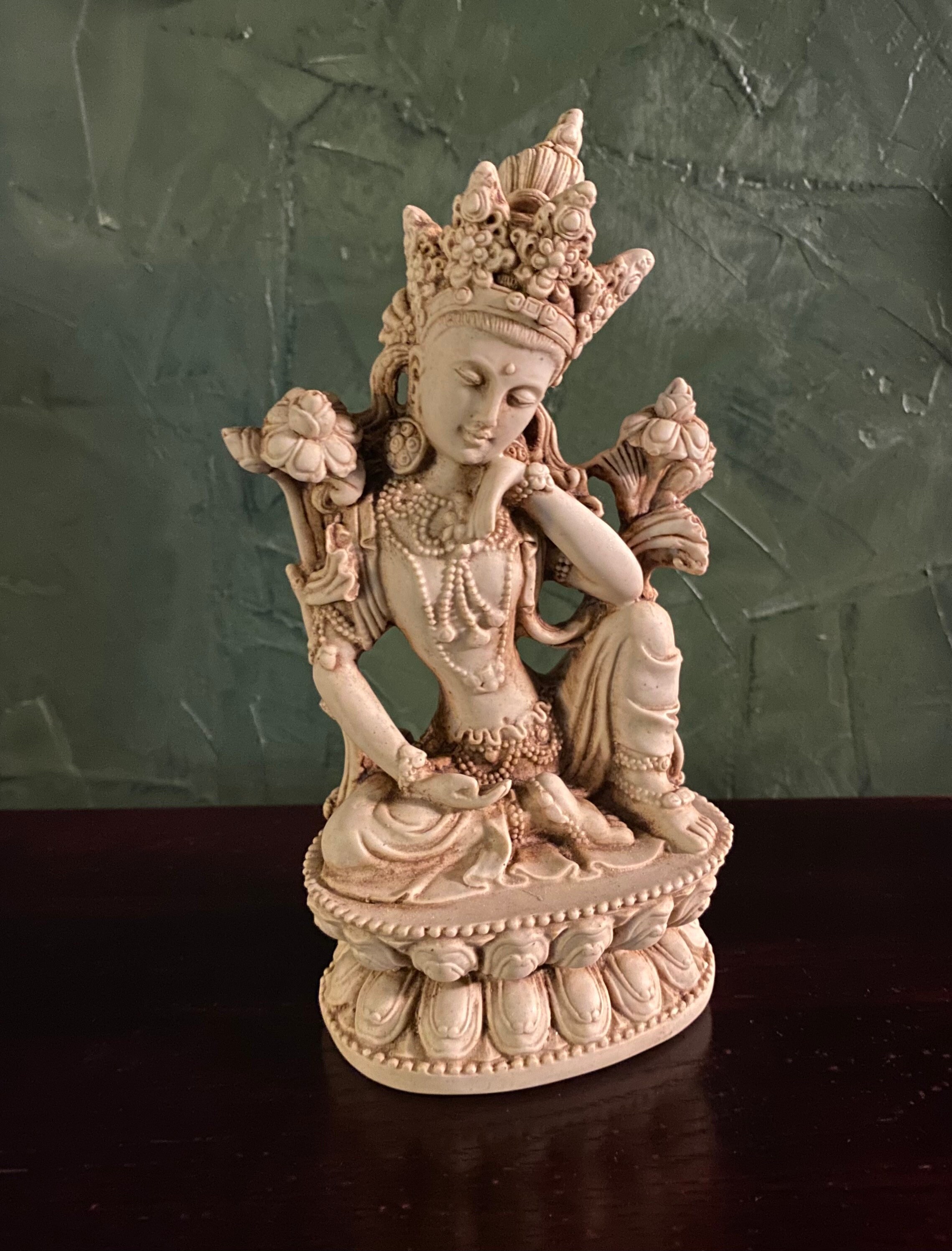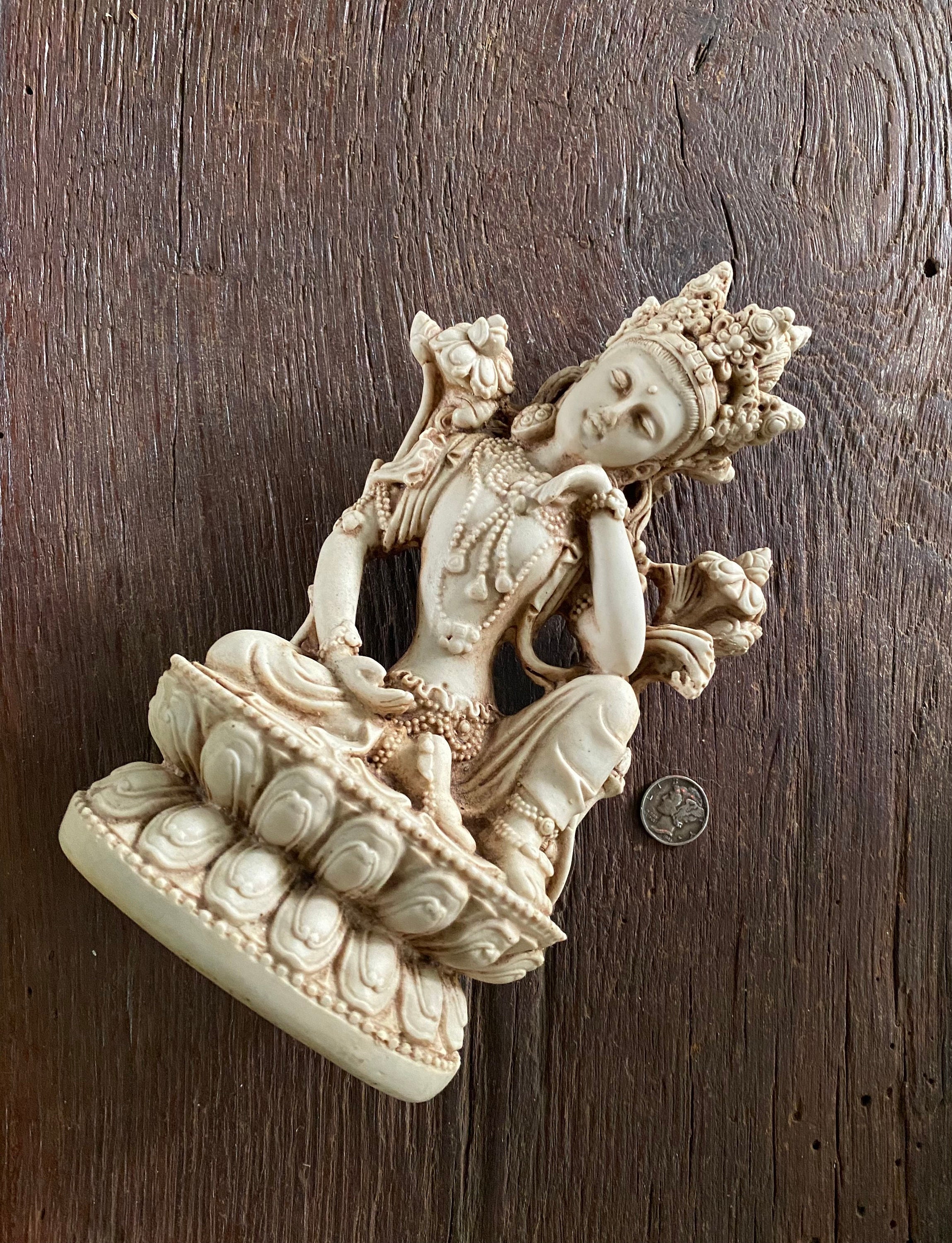1-2/3 LBS, Tara, 8” Tall Bodhisattva of Compassion, India, Resin, GT58
A beautiful and detailed Tara statue that is crafted from resin.
We consider this a Green Tara (although it is not green) largely due to her ease in posture.
Green and White Tara are considered as the goddess of virtuous activity and is a dynamic manifestation of unending compassion.
This item is boxed and wrapped for gifting.
Weight: 1-2/3 pounds, unboxed
Height in Inches: 8 inches +
Width in Inches: 4.75 inches
Thickness in Inches: 3 inches
Made Of: Resin
Made In: India
NO PO BOXES PLEASE! This item CANNOT be shipped to a PO Box.
Ships UPS ground free to the contingent 48 states.
All package items with a combined weight that is 1 pound or greater to International addresses, Alaska, Hawaii, APO, and Puerto Rico: A shipping surcharge applies. You are only charged the difference in freight costs from the shipping costs to the 48 states.
Contact the shop with your order items for a quote of the surcharge amount PRIOR to ordering, please.
The surcharge will be a separate listing that must be paid at the time of order placement.
⭐️Thank you!
Dimensions and Weight may vary slightly from piece to piece.
Tara, as the name suggests, "the one who liberates," is the savior who saves the sentient beings from the great Eight fears.
She is a fully enlightened Buddha, and here enlightened activities are powerful beyond comprehension.
These eight fears that afflict beings exist both externally and inwardly. If they connect with Tara's enlightened activity, people who have worries believe that she will protect them.
These eight great fears are:
Lions
Elephants
Fire
Snakes
Thieves
Drowning
Captivity
Evil Spirits
Tara is the Buddhist savior deity who is believed to be born from Chenrezig's sympathetic tears.
Looking at the world of suffering creatures, the Bodhisattva Chenrezig cried as he saw intensive misery.
Two Tara's were formed from the tears running down his cheeks, a tranquil white one from the left and a ferocious green one from the right.
As a result, Tara is frequently referred to as his consort.
The Forms of Tara:
Buddha Shakyamuni had given many teachings on Tara while turning the Wheel of Dharma for the third time.
His teachings include the inner and outer tantra and the Great Perfection (Dzogpa Chenpo).
These teachings, including the widely prevalent practice of 21 Tara, were brought to Tibet during the time of Guru Padmasambhava, King Triton Detsen, and Master Shantaraksita.
His spiritual consort Yeshe Tsogyal, herself, was considered the emanation of Tara.
And soon, the Tara practice became one of the most popular and influential practices in Tibetan Buddhism.
The Nyingma tradition, the oldest school of Vajrayana, introduced the Tara practice in both Kama and Terma lineage.
It contained various practicing emanations of Tara, which were peaceful, wrathful, and semi wrathful.
The Nirmanakaya form of Tara deals directly with the confusion and distraction caused to all the sentient beings.
Her emanations are boundless and are not confined by external factors such as geography, traditions, and customs.
Tara emanates in various forms as she reaches out to everyone in need.
Among the various forms of Tara, we will be discussing two of her significant emanations: Green Tara and White Tara.
Distinguishing Green Tara and White Tara:
Tara is a Buddhist deity who has various forms.
Even though she is only officially connected with Buddhism in Tibet, Mongolia, and Nepal, she has become one of the most well-known Buddhist deities worldwide.
As the name suggests, Green Tara and the White Tara both have a distinct colors on their body, Emerald Green and radiant white, respectively.
Each Tara has a unique iconography vividly portrayed in the Statues and Thangka paintings.
Similarities between White Tara and Green Tara:
Apart from their distinct body colors, Green and White Tara appear exceptionally peaceful and young.
They both have a single face, two arms, and two legs.
They are seated on a moon disc upon a lotus seat, holding a lotus with her right hand.
The Tara have their upper part of the hair tied in a top knot, wearing a five Jeweled crown on her head included in the eight ornaments and the five silk of a peaceful deity.
The eight jewel adornments
a jeweled crown
jewel earrings
a short necklace
two long necklaces, one longer than the other
a bracelet on each wrist
a golden belt at the waist with loops of jewelry
armlets on each arm
an ankle-let on each foot
The five silks
the silk ribbon hanging from the back of the head
an upper garment
a long scarf
a silk skirt
a lower garment
Differences between White Tara and Green Tara:
Green Tara has a body of emerald green, while White Tara is glowing white like a stainless moon.
Green Tara has two eyes, while the White Tara is portrayed as having seven eyes (three on her face, two on her palms, and two on her legs).
There is a specific posture for each of them.
White Tara is seated in Vajra-paryanka posture while the Green Tara resides in her royal ease posture.
Her right leg is extended forward as she is ready for her action.
Even though both Tara holds a lotus with their right hand, the color of these lotus differs.
Blue lotus (also Utpala) is held by Green Tara, while White Tara has Pundarika (the white one).
Green Tara is frequently represented with a half-opened lotus, which symbolizes night.
White Tara is seen holding a fully bloomed lotus, which means the day.
Green Tara depicts activity, whereas White Tara embodies elegance, peace, and a mother's love for her child.
Together, they signify unending compassion engaged around the globe at all hours of the day and night.
TARA means “star,” “planet,” or “she who ferries across.”
She is a bodhisattva embodying compassion in the female form of a young goddess.
She is often considered to be such an advanced bodhisattva that she is actually a Buddha.
Tara’s name is said to derive from the verb meaning “to cross” or “to traverse”.
In Pali the verb tarati means “to get to the other side.”
This word is cognate with the Latin “trans” (across). The word Tara also literally means “star.”
An interesting overlap between these two senses is the use of stars in navigation.
The Pole Star, used at least for millennia to guide travelers, was known as Dhruva-Tara (the immovable star).
Tara becomes a focal point on the far shore that helps us guide our lives in a safe direction.
We can take her enlightened qualities of wisdom and compassion as our guide, moment by moment, as we navigate our lives.
A third meaning of “tara” is “the pupil of the eye,” again suggesting a focal point and conveying a sense that Tara watches over those who navigate the treacherous waters of life in search of the further shore of liberation.
Tara’s name in Tibetan is Dölma, which means “She Who Saves.”
She is seen as guarding against the Eight Great Terrors of lions, elephants, fire, snakes, robbers, imprisonment, shipwreck or drowning, and man-eating demons.
In each case these terrors are symbolic of spiritual dangers.
For example, the First Dalai Lama described the demons against which Tara offers protection as being our self-consuming spiritual doubts.
The word bodhisattva means as “A being set upon enlightenment,” “One whose essence is perfect knowledge,” or “A being whose essence is enlightenment.”
“Bodhisattva” is a compound word formed from bodhi (spiritual awakening, enlightenment) and sattva (a being, essence, spirit).
There is a possibility that the Pali word “satta” was actually a back-formation from the Sanskrit word sakta, meaning “committed to, fixed or intent upon, directed towards.”
The Pali term “bodhisatta” would, from a Sanskrit point of view, have been ambiguous, and it’s possible that it was retranslated into Sanskrit wrongly as “enlightenment being” when it should have been re-translated as “one committed to enlightenment.”
The word, however, has several shades of meaning, and we will explore these below.
Three meanings of the word “bodhisattva”
There are three principle meanings of the term bodhisattva:
In early Buddhism, the word bodhisattva (or bodhisatta) referred to the historical Buddha, Gautama, before he attained enlightenment.
This meaning covered his previous lives as well as his last life, up until the moment he became enlightened.
In the early scriptures of the Theravada and other schools, he would refer to his life before enlightenment by saying thinks like, “Before my Awakening, when I was still an unawakened Bodhisattva, the thought occurred to me…”There is also a whole class of stories about the Buddha’s previous lives called the Jatakas (birth tales) and in those he’s referred to as “the Bodhisattva.”
The only other beings referred to as “bodhisattva” are mythic Buddhas of the past and future.
For example Maitreya, the next Buddha in our timeline, is currently a Bodhisattva.
And previous Buddhas mentioned in the scriptures, like Vipassi, are referred to as being bodhisattvas before they became enlightened.
In the later schools of Mahayana Buddhism, the term bodhisattva refers to a human being committed to the attainment of enlightenment for the sake of others.
Becoming a bodhisattva is the goal of Mahayana Buddhism.There are scriptures about how to train as a Bodhisattva, such the Bodhisattvacaryāvatāra, or Guide to the Bodhisattva’s Way of Life, also known as the Bodhicaryāvatāra, composed in the 8th century in India by Shantideva (Śāntideva).
This text, which has heavily influenced the practice and teaching of the Dalai Lama, outlines how one develops the Six Perfections of giving, morality, patience, energy, meditation, and wisdom.
Anyone who is set upon enlightenment, not just for themselves alone, but for the sake of all sentient beings, can be described as a bodhisattva, although the term is usually reserved for those of advanced spiritual attainment.
It’s uncommon, in my experience, for anyone to refer to themselves as a bodhisattva.
The word bodhisattva may also refer in Mahayana Buddhism to archetypal bodhisattvas: mythical beings such as Avalokiteshvara and Manjushri.
These are mythic, non-historical figures.
They are objects of reverence and subjects for meditation.
Meditation practices involving them can include the recitation of verses praising their qualities, the visualization of their forms, and the chanting of their mantras.
Ref: wildmind.org
Shipping from United States
Processing time
1-2 business days
Estimated shipping times
- North America : 2 - 5 business days
- Europe : 2 - 5 weeks
- Australia, New Zealand and Oceania : 3 - 5 weeks
I'll do my best to meet these shipping estimates, but can't guarantee them. Actual delivery time will depend on the shipping method you choose.
Customs and import taxes
Buyers are responsible for any customs and import taxes that may apply. I'm not responsible for delays due to customs.
Payment Options
Returns & Exchanges
I don't accept returns, exchanges, or cancellations
But please contact me if you have any problems with your order.
Frequently Asked Questions
Item Descriptions
Stones, Gems, Minerals and other products containing these specimens may include metaphysical information and descriptions concerning unique properties of said minerals, which is derived from anecdotal, folk, native, and other sources, both in person and in print.
All crystal healing uses, magical uses and metaphysical definitions are provided as a means of education, and do not imply a guarantee of effect.
We are not responsible for the use or misuse of our products and further, are not responsible for the actions or inactions resulting from use of our products.
Statements made in our listings are not to be used to diagnose or treat an illness or disease.
LEGAL
By purchasing and/or utilizing Terra Solace, LLC’s products, you agree to hold harmless Terra Solace, LLC, its owners, employees, staff, affiliates, and consultants for any loss, liability, damage and costs that may incurred from the ownership and use or misuse of our products.
This company, its owners, employees, staff and/or representatives are not responsible for the use of any information contained herein or in our website. In no respect shall this company, its owners, employees, staff and/or representatives incur any liability or responsibility for any damages arising out of or resulting from, or any way connected to, the use of or misuse of products, produced or sold.
Buyer assumes title for goods when order ships.
Payments
• Payments must be made through PayPal, direct Etsy checkout (credit card) or Etsy gift cards.
•Orders from states that require sales tax to be collected will be charged sales tax.
• International customers are responsible to pay all customs and duty fees.
Shipping
All orders are processed and shipped within 2 business days and include tracking information. Order information is available to you in your Etsy account purchases page.
• Domestic standard shipping is USPS First Class, which takes 2-5 days to arrive after shipping, depending upon your location.
• International orders may take up to 4 weeks to arrive after shipping. Please contact me to obtain a quote for international orders.
. Priority upgrades are available. Domestic orders of 16 ounces or more are shipped via USPS Priority Mail with $100 postal insurance and tracking. Additional insurance is available when placing your order. We provide reasonable costs.
We are not responsible for loss or damage of orders so please insure.
Delivery Issues/Returns/Refunds
We are not responsible for damaged orders or orders that become lost during transit and will not issue refunds or replacements. We are a small home-based business and are not a corporation.
If your order was shipped Priority Mail, please file a claim online: https://www.usps.com/help/claims.htm
We have a no-return policy, however, if returns are allowed for very specific reasons, refunds will only be issued for the exact item(s) returned in their original condition LESS OUR COSTS OF SHIPPING.
PACKAGES RETURNED as non-deliverable are refundable upon request LESS SHIPPING FEES.
NO EXCEPTIONS...
What are Ubique Botanical Perfumes?
Welcome to Pure Perfume
Ubique is Latin for "everywhere", and refers to Omnipresence, the property of being present everywhere.
u-bi-que [oo-bee-kwe; English] adverb, Latin, "Everywhere".
Ubique Botanical Perfumes contain concentrated botanicals. Plant, flower, wood oils, absolutes, tinctures, and concretes are used and may cause an allergic reaction if you have an allergy to these substances. It is always best to begin your fragrant Ubique journey with a sample before purchasing a larger size, but don't wait too long...these are limited creations and they sell out quickly!
• We do not accept returns on perfumes, personal care items, or sale items. Please purchase and try sample sizes before purchasing larger sizes. Thank you!
Botanical Perfume FAQ's
• Keep products in a cool, dry place away from direct sunlight
• Avoid using near the eyes or other sensitive areas
• Do not take internally
• Keep out of reach of children and pets
• Our products are 100% free of synthetic ingredients.
• All base products used are USDA Certified Organic and also are Non-GMO
As this is pure perfume, only a drop or two is needed. The organic botanical alcohol is NOT drying like the alcohol used in mass marketed perfumes. The EDP's (Eau de Parfum) come in convenient spray bottles.
Mine Rough Stones and Crystals
Mine rough stones are those we procure directly from a mine instead of a mass dealer. These stones are fresh from the earth and have not been previously sold. We prefer mine rough stones as the vibrational qualities are HIGH.
ALL STONES AND CRYSTALS ARE MINED.
One should not expect perfection when purchasing from ANY dealer unless the stone has been cut and polished and is listed as "perfect".
If perfection is desired, please only purchase cut and polished "perfect" stones.
Mine rough stones may have dents, dings, etc. We photograph each stone and describe what we see. We do not sell that which is not of high vibrational quality and authentic.
Namaste...
Lay Away, Holds, and Reserves
We are happy to reserve items that are considered SOLD to you as reserves and are "promises to purchase" .
The maximum hold time is 14 days. The items are considered SOLD to you, awaiting your actual purchase.
In order to reserve an item, one should use the 'Message Cam’ link on the item page, with your request to reserve the item, including the date you plan to purchase it (within the 14 day hold period).
If one fails to purchase the item (s) by the date agreed upon, any future requested reserves will require a non-refundable deposit.
Gift wrapping and packaging
Many items are gift wrapped with the exception of very large items, incense and other small items. By checking the “gift order” box, you are only ensuring a receipt will not be enclosed in the package.
Reviews (2)
Average:
Nov 8, 2022
Lovely item and fast delivery.
Sep 15, 2022
Gorgeous Green Tara statue. Packaged beautifully with additional gifts and arrived quickly.

